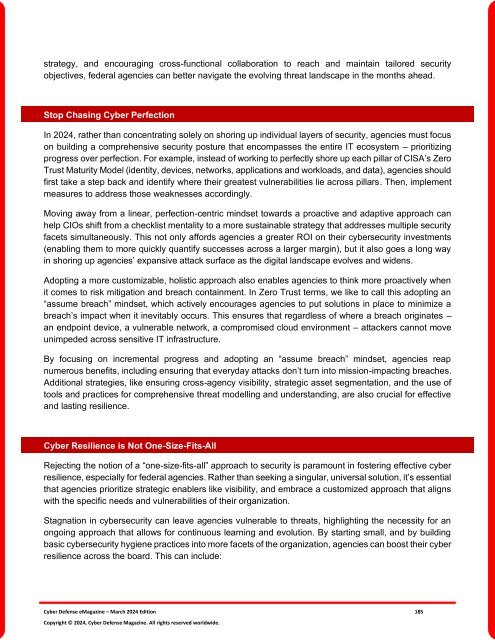The Cyber Defense eMagazine March Edition for 2024
Cyber Defense eMagazine March Edition for 2024 #CDM #CYBERDEFENSEMAG @CyberDefenseMag by @Miliefsky a world-renowned cyber security expert and the Publisher of Cyber Defense Magazine as part of the Cyber Defense Media Group as well as Yan Ross, Editor-in-Chief and many more writers, partners and supporters who make this an awesome publication! 225 page March Edition fully packed with some of our best content. Thank you all and to our readers! OSINT ROCKS! #CDM #CDMG #OSINT #CYBERSECURITY #INFOSEC #BEST #PRACTICES #TIPS #TECHNIQUES
Cyber Defense eMagazine March Edition for 2024 #CDM #CYBERDEFENSEMAG @CyberDefenseMag by @Miliefsky a world-renowned cyber security expert and the Publisher of Cyber Defense Magazine as part of the Cyber Defense Media Group as well as Yan Ross, Editor-in-Chief and many more writers, partners and supporters who make this an awesome publication! 225 page March Edition fully packed with some of our best content. Thank you all and to our readers! OSINT ROCKS! #CDM #CDMG #OSINT #CYBERSECURITY #INFOSEC #BEST #PRACTICES #TIPS #TECHNIQUES
Create successful ePaper yourself
Turn your PDF publications into a flip-book with our unique Google optimized e-Paper software.
strategy, and encouraging cross-functional collaboration to reach and maintain tailored security<br />
objectives, federal agencies can better navigate the evolving threat landscape in the months ahead.<br />
Stop Chasing <strong>Cyber</strong> Perfection<br />
In <strong>2024</strong>, rather than concentrating solely on shoring up individual layers of security, agencies must focus<br />
on building a comprehensive security posture that encompasses the entire IT ecosystem – prioritizing<br />
progress over perfection. For example, instead of working to perfectly shore up each pillar of CISA’s Zero<br />
Trust Maturity Model (identity, devices, networks, applications and workloads, and data), agencies should<br />
first take a step back and identify where their greatest vulnerabilities lie across pillars. <strong>The</strong>n, implement<br />
measures to address those weaknesses accordingly.<br />
Moving away from a linear, perfection-centric mindset towards a proactive and adaptive approach can<br />
help CIOs shift from a checklist mentality to a more sustainable strategy that addresses multiple security<br />
facets simultaneously. This not only af<strong>for</strong>ds agencies a greater ROI on their cybersecurity investments<br />
(enabling them to more quickly quantify successes across a larger margin), but it also goes a long way<br />
in shoring up agencies’ expansive attack surface as the digital landscape evolves and widens.<br />
Adopting a more customizable, holistic approach also enables agencies to think more proactively when<br />
it comes to risk mitigation and breach containment. In Zero Trust terms, we like to call this adopting an<br />
“assume breach” mindset, which actively encourages agencies to put solutions in place to minimize a<br />
breach’s impact when it inevitably occurs. This ensures that regardless of where a breach originates –<br />
an endpoint device, a vulnerable network, a compromised cloud environment – attackers cannot move<br />
unimpeded across sensitive IT infrastructure.<br />
By focusing on incremental progress and adopting an “assume breach” mindset, agencies reap<br />
numerous benefits, including ensuring that everyday attacks don’t turn into mission-impacting breaches.<br />
Additional strategies, like ensuring cross-agency visibility, strategic asset segmentation, and the use of<br />
tools and practices <strong>for</strong> comprehensive threat modelling and understanding, are also crucial <strong>for</strong> effective<br />
and lasting resilience.<br />
<strong>Cyber</strong> Resilience is Not One-Size-Fits-All<br />
Rejecting the notion of a “one-size-fits-all” approach to security is paramount in fostering effective cyber<br />
resilience, especially <strong>for</strong> federal agencies. Rather than seeking a singular, universal solution, it’s essential<br />
that agencies prioritize strategic enablers like visibility, and embrace a customized approach that aligns<br />
with the specific needs and vulnerabilities of their organization.<br />
Stagnation in cybersecurity can leave agencies vulnerable to threats, highlighting the necessity <strong>for</strong> an<br />
ongoing approach that allows <strong>for</strong> continuous learning and evolution. By starting small, and by building<br />
basic cybersecurity hygiene practices into more facets of the organization, agencies can boost their cyber<br />
resilience across the board. This can include:<br />
<strong>Cyber</strong> <strong>Defense</strong> <strong>eMagazine</strong> – <strong>March</strong> <strong>2024</strong> <strong>Edition</strong> 185<br />
Copyright © <strong>2024</strong>, <strong>Cyber</strong> <strong>Defense</strong> Magazine. All rights reserved worldwide.

















